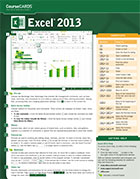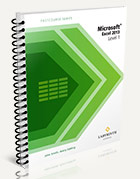By Eric Weinstein, author of Labyrinth Learning’s Excel for Accounting and Payroll Accounting


By Eric Weinstein, author of Labyrinth Learning’s Excel for Accounting and Payroll Accounting


Microsoft Excel has in record time become one of the most popular programs in both the corporate and small business world, as well as for home use. However, beginners experience moments of panic when delving into the inner workings of this versatile application.
Excel offers thousands of features so creating a system of understanding how to add onto the quick access toolbar, what a ribbon is and remembering keyboard shortcuts is vital to the overall success of learning Microsoft Excel.
That is why Labyrinth Learning is pleased to offer Microsoft Excel 2013 CourseCARD. Instead of students laboring over physical note taking, frequently distracting them from the next topic being introduced, our Microsoft Excel 2013 CourseCARD provides students with a quick and easy to understand reference guide.
More than just a step by step list that students follow to solve a problem, CourseCARD explains how Excel functions and details the necessary features and tools so each worksheet can operate properly. There are also basic and advanced topic sections along with a top productivity tips and solutions page.
The basic topic section includes tips on entering information, formulating data and managing worksheets, while the more advanced section discusses some of Excel’s newer features, including sparklines and PivotChart field buttons. The solutions page is a quick reference guide on customizing methods, creating specialized templates and worksheets and how to open older versions of Excel.
For information about our additional teaching aids, please contact us at Labyrinth Learning today.


Accounting for beginners can be intimidating. However, our basic accounting course can easily reduce much of the stress and worry students often experience when learning something new.
The ABC’s of Accounting has been an excellent resource for students in years past, and now we are offering our newest textbook, Accounting Basics: An Introduction for Non-Accounting Majors. Just as with the first course, this textbook includes coverage of accounting practices including a standard accounting cycle.
Since this course is designed to teach basic accounting practices to students not working toward an accounting degree, the pace is slower and fewer in-depth topics are reviewed. The accounting cycle is initially introduced as an overview so students can get a general idea of what responsibilities a typical company accountant handles on a daily basis.
Our accounting for beginners course provides clear concise examples immediately after each new subject is introduced, giving students additional visual teaching tools. Plus, there is additional dialogue to ensure students not only understand how to perform a particular accounting procedure but the reasons behind the process.
The same fictional company is used throughout the course and each chapter includes two practice sets, an end of the chapter problem building off the previous chapter’s problem, and a wide range of all-inclusive learning projects so each student can begin to apply them to real-time scenarios.
Labyrinth Learning offers excellent interactive teaching tools for all levels of accounting instruction. Please contact us for additional assistance and product availability.


It’s important to teach certain subjects, such as accounting, in a way that students both comprehend and retain the information. Here are some helpful tips on how to teach accounting:
When learning how to teach accounting, Labyrinth Learning offers an excellent variety of both textbooks and online teaching tools to help both you and your students succeed. Please contact us today for assistance.

If it has been a while since you attended a brush-up course on Microsoft Excel, you’ll know this feeling; you leave the seminar inspired. You can’t wait to get to work and use the new tricks at work, but over the course of a few weeks, you’re lucky if three or four of the new shortcuts you learned make it into your daily rotation. Sound familiar?
Here are some simple Microsoft Excel 2013 tricks you can share at your weekly meeting to keep coworkers up to speed.
Select All. Quick keyboard commands can shave seconds, which quickly add up to minutes and hours, off of your everyday computer tasks. [Ctrl]+A can be used to select all of the data in your Excel spreadsheet at one time. It also works in Word and other Windows applications.
Copy/Transfer Formatting. Here’s a trick you’ll really thank us for. The Excel Format Painter Tool is often neglected, but not for long. When you want to transfer the cell formatting (not formula), simply select the cell and right click. See the paint brush in the bottom-right corner? Select it. Then click on any other cell(s) and the identical formatting will be copied.
Display formulas. When you hit [Ctrl] + ~, all of the formulas in a spreadsheet will be visible, allowing you to edit/tweak them as needed.
Labyrinth Learning has a host of Microsoft Excel 2013 products that can teach your employees basic and advanced skills, or can be used for a FastCourse refresher at your next training seminar.

 When you are dealing with a spreadsheet all day, you have to deal with hundreds of calculations, thousands of cells and dozens of pages. Throughout the day clicking through a series of menus and finding the right buttons can add up to a lot of extra time.
When you are dealing with a spreadsheet all day, you have to deal with hundreds of calculations, thousands of cells and dozens of pages. Throughout the day clicking through a series of menus and finding the right buttons can add up to a lot of extra time.
Luckily all of your common productivity programs have built in shortcuts to make quick work of your work. Here are just a few Microsoft Excel 2013 keyboard shortcuts that can boost productivity in your workforce.
Labyrinth Learning offers multiple levels of Excel course materials so your students can utilize efficient, time-saving keyboard shortcuts.